Hirohito
Hirohito[lower-alpha 1] (裕仁, 29 April 1901 – 7 January 1989) was the 124th emperor of Japan according to the traditional order of succession. He reigned as the emperor of the Empire of Japan (大日本帝國) from 25 December 1926 until 2 May 1947 and of the state of Japan (日本国) from 3 May 1947 until his death on 7 January 1989. He was succeeded by his fifth child and eldest son, Akihito. Hirohito and his wife, Empress Kojun, had seven children, two sons and five daughters. In Japan, reigning emperors are known only as "the Emperor." He is now referred to primarily by his posthumous name, Shōwa (昭和), which is the name of the era coinciding with his reign; for this reason, he is also known as the Shōwa Emperor or Emperor Shōwa. By 1979, Hirohito was the only monarch in the world with the highest monarchical title "emperor." Hirohito was the longest-lived and longest-reigning historical Japanese emperor and one of the longest-reigning monarchs in the world.
At the start of his reign, Japan was already one of the great powers—the ninth largest economy in the world, the third-largest naval power, and one of the four permanent members of the council of the League of Nations.[3] He was the head of state under the Constitution of the Empire of Japan during Japan's imperial expansion, militarization, and involvement in World War II. After Japan's surrender, he was not prosecuted for war crimes as many other leading government figures were. His degree of involvement in wartime decisions remains controversial.[4] During the post-war period, he became the symbol of the state of Japan under the post-war constitution and Japan's recovery. By the end of his reign, Japan emerged as the world's second-largest economy.[5]
Early life
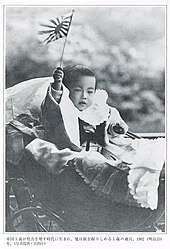
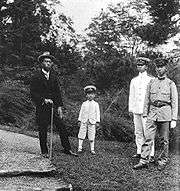
Born in Tokyo's Aoyama Palace (during the reign of his grandfather, Emperor Meiji) on 29 April 1901,[6] Hirohito was the first son of 21-year-old Crown Prince Yoshihito (the future Emperor Taishō) and 17-year-old Crown Princess Sadako (the future Empress Teimei).[7] He was the grandson of Emperor Meiji and Yanagihara Naruko. His childhood title was Prince Michi. Ten weeks after he was born, Hirohito was removed from the court and placed in the care of Count Kawamura Sumiyoshi, who raised him as his grandchild. At the age of 3, Hirohito and his brother Yasuhito were returned to court when Kawamura died – first to the imperial mansion in Numazu, Shizuoka, then back to the Aoyama Palace.[8] In 1908 he began elementary studies at the Gakushūin (Peers School).
Crown Prince era
When his grandfather, Emperor Meiji, died on 30 July 1912, Hirohito's father, Yoshihito, assumed the throne. Hirohito became the heir apparent, and he was formally commissioned as a second lieutenant in the army and an ensign in the navy. He was also decorated with the Grand Cordon of the Order of the Chrysanthemum. In 1914, he was promoted to the ranks of Lieutenant in the army and Sub-Lieutenant in the navy. In 1916, he was promoted to Captain and Lieutenant in the army and navy. Hirohito was formally proclaimed Crown Prince and heir apparent on 2 November 1916. An investiture ceremony was not required to confirm this status.[9]
Hirohito attended Gakushūin Peers' School from 1908 to 1914 and then a special institute for the crown prince (Tōgū-gogakumonsho) from 1914 to 1921. In 1920 Hirohito was promoted to the rank of Major in the army and Lieutenant Commander in the navy.
Excursion
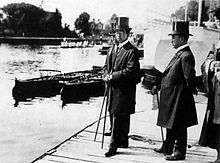
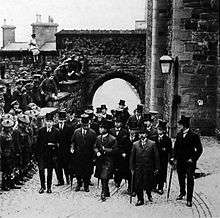
From 3 March to 3 September 1921 (Taisho 10), the Crown Prince made official visits to the United Kingdom, France, the Netherlands, Belgium, Italy and Vatican City. This was the first visit to Europe by the Crown Prince.[lower-alpha 2] Despite strong opposition in Japan, this was realized by the efforts of elder Japanese statesmen (Genrō) such as Yamagata Aritomo and Saionji Kinmochi.
The departure of Prince Hirohito was widely reported in newspapers. The Japanese battleship Katori was used and departed from Yokohama, sailed to Naha, Hong Kong, Singapore, Colombo, Suez, Cairo, and Gibraltar. It arrived in Portsmouth two months later on 9 May, and on the same day they reached the British capital London. He was welcomed in the UK as a partner of the Anglo-Japanese Alliance and met with King George V and Prime Minister David Lloyd George. That evening, a banquet was held at Buckingham Palace and a meeting with George V and Prince Arthur of Connaught. George V said that he treated his father like Hirohito, who was nervous in an unfamiliar foreign country, and that relieved his tension. The next day, he met Prince Edward at Windsor Castle, and a banquet was held every day thereafter. In London, he toured the British Museum, Tower of London, Bank of England, Lloyd's Marine Insurance, Oxford University, Army University, and Naval War College. He also enjoyed theater at the New Oxford Theater and the Delhi Theater.[10] At Cambridge University, he listened to Professor Tanner's lecture on "Relationship between the British Royal Family and its People" and was awarded an honorary doctorate degree.[11] He visited Edinburgh, Scotland, from the 19th to the 20th, and was also awarded an Honorary Doctor of Laws at the University of Edinburgh. He stayed at the residence of John Stewart-Murray, 7th Duke of Atholl, for three days. "The rise of Bolsheviks won't happen if you live a simple life like Duke Athol."[11]
In Italy, he met with King Vittorio Emanuele III and others, attended official banquets in various countries, and visited places such as the fierce battlefields of World War I.
Regency
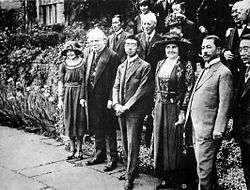
After returning to Japan, Hirohito became Regent of Japan (Sesshō) on 29 November 1921, in place of his ailing father, who was affected by mental illness. In 1923 he was promoted to the rank of Lieutenant-Colonel in the army and Commander in the navy, and army Colonel and Navy Captain in 1925.
During Hirohito's regency, many important events occurred:
In the Four-Power Treaty on Insular Possessions signed on 13 December 1921, Japan, the United States, Britain, and France agreed to recognize the status quo in the Pacific. Japan and Britain agreed to end the Anglo-Japanese Alliance. The Washington Naval Treaty was signed on 6 February 1922. Japan withdrew troops from the Siberian Intervention on 28 August 1922. The Great Kantō earthquake devastated Tokyo on 1 September 1923. On 27 December 1923, Daisuke Namba attempted to assassinate Hirohito in the Toranomon Incident, but his attempt failed. During interrogation, he claimed to be a communist and was executed, but some have suggested that he was in contact with the Nagacho faction in the Army.
Marriage
Prince Hirohito married his distant cousin Princess Nagako Kuni (the future Empress Kōjun), the eldest daughter of Prince Kuniyoshi Kuni, on 26 January 1924. They had two sons and five daughters[12] (see Issue).
The daughters who lived to adulthood left the imperial family as a result of the American reforms of the Japanese imperial household in October 1947 (in the case of Princess Shigeko) or under the terms of the Imperial Household Law at the moment of their subsequent marriages (in the cases of Princesses Kazuko, Atsuko, and Takako).
Ascension
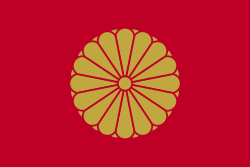
On 25 December 1926, Hirohito assumed the throne upon the death of his father, Yoshihito. The Crown Prince was said to have received the succession (senso).[13] The Taishō era's end and the Shōwa era's beginning (Enlightened Peace) were proclaimed. The deceased Emperor was posthumously renamed Emperor Taishō within days. Following Japanese custom, the new Emperor was never referred to by his given name but rather was referred to simply as "His Majesty the Emperor" which may be shortened to "His Majesty." In writing, the Emperor was also referred to formally as "The Reigning Emperor."
In November 1928, the Emperor's ascension was confirmed in ceremonies (sokui)[13] which are conventionally identified as "enthronement" and "coronation" (Shōwa no tairei-shiki); but this formal event would have been more accurately described as a public confirmation that his Imperial Majesty possesses the Japanese Imperial Regalia,[14] also called the Three Sacred Treasures, which have been handed down through the centuries.[15]
Early reign

The first part of Hirohito's reign took place against a background of financial crisis and increasing military power within the government through both legal and extralegal means. The Imperial Japanese Army and Imperial Japanese Navy held veto power over the formation of cabinets since 1900. Between 1921 and 1944, there were no fewer than 64 incidents of political violence.
Hirohito narrowly escaped assassination by a hand grenade thrown by a Korean independence activist, Lee Bong-chang, in Tokyo on 9 January 1932, in the Sakuradamon Incident.
Another notable case was the assassination of moderate Prime Minister Inukai Tsuyoshi in 1932, marking the end of civilian control of the military. The February 26 incident, an attempted military coup, followed in February 1936. It was carried out by junior Army officers of the Kōdōha faction who had the sympathy of many high-ranking officers including Prince Chichibu (Yasuhito), one of the Emperor's brothers. This revolt was occasioned by a loss of political support by the militarist faction in Diet elections. The coup resulted in the murders of several high government and Army officials.
When Chief Aide-de-camp Shigeru Honjō informed him of the revolt, the Emperor immediately ordered that it be put down and referred to the officers as "rebels" (bōto). Shortly thereafter, he ordered Army Minister Yoshiyuki Kawashima to suppress the rebellion within the hour. He asked for reports from Honjō every 30 minutes. The next day, when told by Honjō that the high command had made little progress in quashing the rebels, the Emperor told him "I Myself, will lead the Konoe Division and subdue them." The rebellion was suppressed following his orders on 29 February.[16]
Second Sino-Japanese War

Starting from the Mukden Incident in 1931, Japan occupied Chinese territories and established puppet governments. Such "aggression was recommended to Hirohito" by his chiefs of staff and prime minister Fumimaro Konoe, and Hirohito never personally objected to any invasion of China.[17] His main concern seems to have been the possibility of an attack by the Soviet Union in the north. His questions to his chief of staff, Prince Kan'in, and minister of the army, Hajime Sugiyama, were mostly about the time it could take to crush Chinese resistance.
According to Akira Fujiwara, Hirohito endorsed the policy of qualifying the invasion of China as an "incident" instead of a "war"; therefore, he did not issue any notice to observe international law in this conflict (unlike what his predecessors did in previous conflicts officially recognized by Japan as wars), and the Deputy Minister of the Japanese Army instructed the chief of staff of Japanese China Garrison Army on 5 August not to use the term "prisoners of war" for Chinese captives. This instruction led to the removal of the constraints of international law on the treatment of Chinese prisoners.[18] The works of Yoshiaki Yoshimi and Seiya Matsuno show that the Emperor also authorized, by specific orders (rinsanmei), the use of chemical weapons against the Chinese.[19] During the invasion of Wuhan, from August to October 1938, the Emperor authorized the use of toxic gas on 375 separate occasions,[20] despite the resolution adopted by the League of Nations on 14 May condemning Japanese use of toxic gas.
World War II
Preparations
In July 1939, the Emperor quarrelled with his brother, Prince Chichibu, over whether to support the treaty, and he reprimanded the army minister, Seishirō Itagaki.[21] But after the success of the Wehrmacht in Europe, the Emperor consented to the alliance. On 27 September 1940, ostensibly under Hirohito's leadership, Japan became a contracting partner of the Tripartite Pact with Germany and Italy forming the Axis Powers.
On 4 September 1941, the Japanese Cabinet met to consider war plans prepared by Imperial General Headquarters and decided that:
Our Empire, for the purpose of self-defence and self-preservation, will complete preparations for war ... [and is] ... resolved to go to war with the United States, Great Britain, and the French if necessary. Our Empire will concurrently take all possible diplomatic measures vis-à-vis the United States and Great Britain, and thereby endeavor to obtain our objectives ... In the event that there is no prospect of our demands being met by the first ten days of October through the diplomatic negotiations mentioned above, we will immediately decide to commence hostilities against the United States, Britain and the French.
The objectives to be obtained were clearly defined: a free hand to continue with the conquest of China and Southeast Asia, no increase in US or British military forces in the region, and cooperation by the West "in the acquisition of goods needed by our Empire."
On 5 September, Prime Minister Konoe informally submitted a draft of the decision to the Emperor, just one day in advance of the Imperial Conference at which it would be formally implemented. On this evening, the Emperor had a meeting with the chief of staff of the army, Sugiyama, chief of staff of the navy, Osami Nagano, and Prime Minister Konoe. The Emperor questioned Sugiyama about the chances of success of an open war with the Occident. As Sugiyama answered positively, the Emperor scolded him:
—At the time of the China Incident, the army told me that we could achieve peace immediately after dealing them one blow with three divisions ... but you can't still beat Chiang Kai-shek even today! Sugiyama, you were army minister at that time.
—China is a vast area with many ways in and ways out, and we met unexpectedly big difficulties ...
—You say the interior of China is huge; isn't the Pacific Ocean even bigger than China? ... Didn't I caution you each time about those matters? Sugiyama, are you lying to me?[22]
Chief of Naval General Staff Admiral Nagano, a former Navy Minister and vastly experienced, later told a trusted colleague, "I have never seen the Emperor reprimand us in such a manner, his face turning red and raising his voice."
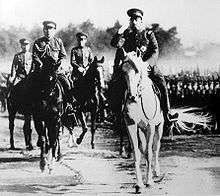
Nevertheless, all speakers at the Imperial Conference were united in favor of war rather than diplomacy.[23] Baron Yoshimichi Hara, President of the Imperial Council and the Emperor's representative, then questioned them closely, producing replies to the effect that war would be considered only as a last resort from some, and silence from others.
At this point, the Emperor astonished all present by addressing the conference personally. In breaking the tradition of Imperial silence, he left his advisors "struck with awe." (Prime Minister Fumimaro Konoe's description of the event.) Hirohito stressed the need for peaceful resolution of international problems, expressed regret at his ministers' failure to respond to Baron Hara's probings, and recited a poem written by his grandfather, Emperor Meiji, which, he said, he had read "over and over again":
The seas of the four directions—
all are born of one womb:
why, then, do the wind and waves rise in discord?[24]
Recovering from their shock, the ministers hastened to express their profound wish to explore all possible peaceful avenues. The Emperor's presentation was in line with his practical role as leader of the State Shinto religion.
At this time, Army Imperial Headquarters was continually communicating with the Imperial household in detail about the military situation. On 8 October, Sugiyama signed a 47-page report to the Emperor (sōjōan) outlining in minute detail plans for the advance into Southeast Asia. During the third week of October, Sugiyama gave the Emperor a 51-page document, "Materials in Reply to the Throne," about the operational outlook for the war.[25]
As war preparations continued, Prime Minister Fumimaro Konoe found himself increasingly isolated, and he resigned on 16 October. He justified himself to his chief cabinet secretary, Kenji Tomita, by stating:
Of course His Majesty is a pacifist, and there is no doubt he wished to avoid war. When I told him that to initiate war was a mistake, he agreed. But the next day, he would tell me: "You were worried about it yesterday, but you do not have to worry so much." Thus, gradually, he began to lean toward war. And the next time I met him, he leaned even more toward. In short, I felt the Emperor was telling me: my prime minister does not understand military matters, I know much more. In short, the Emperor had absorbed the view of the army and navy high commands.[26]
The army and the navy recommended the candidacy of Prince Naruhiko Higashikuni, one of the Emperor's uncles. According to the Shōwa "Monologue," written after the war, the Emperor then said that if the war were to begin while a member of the imperial house was prime minister, the imperial house would have to carry the responsibility and he was opposed to this.[27]
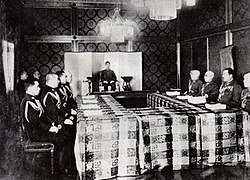
Instead, the Emperor chose the hard-line General Hideki Tōjō, who was known for his devotion to the imperial institution, and asked him to make a policy review of what had been sanctioned by the Imperial Conferences. On 2 November Tōjō, Sugiyama, and Nagano reported to the Emperor that the review of eleven points had been in vain. Emperor Hirohito gave his consent to the war and then asked: "Are you going to provide justification for the war?"[28] The decision for war against the United States was presented for approval to Hirohito by General Tōjō, Naval Minister Admiral Shigetarō Shimada, and Japanese Foreign Minister Shigenori Tōgō.[29]
On 3 November, Nagano explained in detail the plan of the attack on Pearl Harbor to the Emperor.[30] On 5 November Emperor Hirohito approved in imperial conference the operations plan for a war against the Occident and had many meetings with the military and Tōjō until the end of the month.[31] On 25 November Henry L. Stimson, United States Secretary of War, noted in his diary that he had discussed with US President Franklin D. Roosevelt the severe likelihood that Japan was about to launch a surprise attack and that the question had been "how we should maneuver them [the Japanese] into the position of firing the first shot without allowing too much danger to ourselves."
On the following day, 26 November 1941, US Secretary of State Cordell Hull presented the Japanese ambassador with the Hull note, which as one of its conditions demanded the complete withdrawal of all Japanese troops from French Indochina and China. Japanese Prime Minister Hideki Tojo said to his cabinet, "This is an ultimatum." On 1 December an Imperial Conference sanctioned the "War against the United States, United Kingdom and the Kingdom of the Netherlands."[32]
War: advance and retreat
On 8 December (7 December in Hawaii), 1941, in simultaneous attacks, Japanese forces struck at the Hong Kong Garrison, the US Fleet in Pearl Harbor and in the Philippines, and began the invasion of Malaya.
With the nation fully committed to the war, the Emperor took a keen interest in military progress and sought to boost morale. According to Akira Yamada and Akira Fujiwara, the Emperor made major interventions in some military operations. For example, he pressed Sugiyama four times, on 13 and 21 January and 9 and 26 February, to increase troop strength and launch an attack on Bataan. On 9 February 19 March, and 29 May, the Emperor ordered the Army Chief of staff to examine the possibilities for an attack on Chungking, which led to Operation Gogo.[33]
As the tide of war began to turn against Japan (around late 1942 and early 1943), the flow of information to the palace gradually began to bear less and less relation to reality, while others suggest that the Emperor worked closely with Prime Minister Hideki Tojo, continued to be well and accurately briefed by the military, and knew Japan's military position precisely right up to the point of surrender. The chief of staff of the General Affairs section of the Prime Minister's office, Shuichi Inada, remarked to Tōjō's private secretary, Sadao Akamatsu:
There has never been a cabinet in which the prime minister, and all the ministers, reported so often to the throne. In order to effect the essence of genuine direct imperial rule and to relieve the concerns of the Emperor, the ministers reported to the throne matters within the scope of their responsibilities as per the prime minister's directives ... In times of intense activities, typed drafts were presented to the Emperor with corrections in red. First draft, second draft, final draft and so forth, came as deliberations progressed one after the other and were sanctioned accordingly by the Emperor.[34]
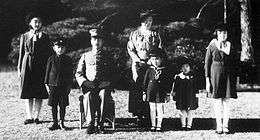
In the first six months of war, all the major engagements had been victories. Japanese advances were stopped in the summer of 1942 with the battle of Midway and the landing of the American forces on Guadalcanal and Tulagi in August. The emperor played an increasingly influential role in the war; in eleven major episodes he was deeply involved in supervising the actual conduct of war operations. Hirohito pressured the High Command to order an early attack on the Philippines in 1941-42, including the fortified Bataan peninsula. He secured the deployment of army air power in the Guadalcanal campaign. Following Japan's withdrawal from Guadalcanal he demanded a new offensive in New Guinea, which was duly carried out but failed badly. Unhappy with the navy's conduct of the war, he criticized its withdrawal from the central Solomon Islands and demanded naval battles against the Americans for the losses they had inflicted in the Aleutians. The battles were disasters. Finally, it was at his insistence that plans were drafted for the recapture of Saipan and, later, for an offensive in the Battle of Okinawa.[35] With the Army and Navy bitterly feuding, he settled disputes over the allocation of resources. He helped plan military offenses.[36]
The media, under tight government control, repeatedly portrayed him as lifting the popular morale even as the Japanese cities came under heavy air attack in 1944-45 and food and housing shortages mounted. Japanese retreats and defeats were celebrated by the media as successes that portended "Certain Victory."[37] Only gradually did it become apparent to the Japanese people that the situation was very grim due to growing shortages of food, medicine, and fuel as U.S submarines began wiping out Japanese shipping. Starting in mid 1944, American raids on the major cities of Japan made a mockery of the unending tales of victory. Later that year, with the downfall of Tojo's government, two other prime ministers were appointed to continue the war effort, Kuniaki Koiso and Kantarō Suzuki—each with the formal approval of the Emperor. Both were unsuccessful and Japan was nearing disaster.[38]
Surrender
.jpg)
In early 1945, in the wake of the losses in the Battle of Leyte, Emperor Hirohito began a series of individual meetings with senior government officials to consider the progress of the war. All but ex-Prime Minister Fumimaro Konoe advised continuing the war. Konoe feared a communist revolution even more than defeat in war and urged a negotiated surrender. In February 1945 during the first private audience with the Emperor he had been allowed in three years,[39] Konoe advised Hirohito to begin negotiations to end the war. According to Grand Chamberlain Hisanori Fujita, the Emperor, still looking for a tennozan (a great victory) in order to provide a stronger bargaining position, firmly rejected Konoe's recommendation.[40]
With each passing week victory became less likely. In April, the Soviet Union issued notice that it would not renew its neutrality agreement. Japan's ally Germany surrendered in early May 1945. In June the cabinet reassessed the war strategy, only to decide more firmly than ever on a fight to the last man. This strategy was officially affirmed at a brief Imperial Council meeting, at which, as was normal, the Emperor did not speak.
The following day, Lord Keeper of the Privy Seal Kōichi Kido prepared a draft document which summarized the hopeless military situation and proposed a negotiated settlement. Extremists in Japan were also calling for a death-before-dishonor mass suicide, modeled on the "47 Ronin" incident. By mid-June 1945 the cabinet had agreed to approach the Soviet Union to act as a mediator for a negotiated surrender but not before Japan's bargaining position had been improved by repulse of the anticipated Allied invasion of mainland Japan.
On 22 June the Emperor met with his ministers saying, "I desire that concrete plans to end the war, unhampered by existing policy, be speedily studied and that efforts be made to implement them." The attempt to negotiate a peace via the Soviet Union came to nothing. There was always the threat that extremists would carry out a coup or foment other violence. On 26 July 1945, the Allies issued the Potsdam Declaration demanding unconditional surrender. The Japanese government council, the Big Six, considered that option and recommended to the Emperor that it be accepted only if one to four conditions were agreed upon, including a guarantee of the Emperor's continued position in Japanese society. The Emperor decided not to surrender.
That changed after the atomic bombings of Hiroshima and Nagasaki and the Soviet declaration of war. On 9 August Emperor Hirohito told Kōichi Kido: "The Soviet Union has declared war and today began hostilities against us."[41] On 10 August, the cabinet drafted an "Imperial Rescript ending the War" following the Emperor's indications that the declaration did not compromise any demand which prejudiced the prerogatives of His Majesty as a Sovereign Ruler.
On 12 August 1945, the Emperor informed the imperial family of his decision to surrender. One of his uncles, Prince Yasuhiko Asaka, asked whether the war would be continued if the kokutai (national polity) could not be preserved. The Emperor simply replied "Of course."[42] On 14 August the Suzuki government notified the Allies that it had accepted the Potsdam Declaration.
On 15 August a recording of the Emperor's surrender speech ("Gyokuon-hōsō", literally "Jewel Voice Broadcast") was broadcast over the radio (the first time the Emperor was heard on the radio by the Japanese people) announcing Japan's acceptance of the Potsdam Declaration. During the historic broadcast the Emperor stated: "Moreover, the enemy has begun to employ a new and most cruel bomb, the power of which to do damage is, indeed, incalculable, taking the toll of many innocent lives. Should we continue to fight, not only would it result in an ultimate collapse and obliteration of the Japanese nation, but also it would lead to the total extinction of human civilization." The speech also noted that "the war situation has developed not necessarily to Japan's advantage" and ordered the Japanese to "endure the unendurable." The speech, using formal, archaic Japanese, was not readily understood by many commoners. According to historian Richard Storry in A History of Modern Japan, the Emperor typically used "a form of language familiar only to the well-educated" and to the more traditional samurai families.[43]
A faction of the army opposed to the surrender attempted a coup d'état on the evening of 14 August, prior to the broadcast. They seized the Imperial Palace (the Kyūjō incident), but the physical recording of the emperor's speech was hidden and preserved overnight. The coup was crushed by the next morning, and the speech was broadcast.[44]
In his first ever press conference given in Tokyo in 1975, when he was asked what he thought of the bombing of Hiroshima, the Emperor answered: "It's very regrettable that nuclear bombs were dropped and I feel sorry for the citizens of Hiroshima but it couldn't be helped because that happened in wartime" (shikata ga nai).[45]
Accountability for Japanese war crimes
The issue of Emperor Hirohito's war responsibility is a controversial matter.[4] There is no consensus among scholars. During wartime the allies frequently depicted Hirohito to equate with Hitler and Mussolini as the three Axis dictators.[46] The apologist thesis, which argues that Hirohito had been a "powerless figurehead" without any implication in wartime policies, was the dominant postwar narrative until 1989.[47][48] After Hirohito's death, the critical historians[49] say that Hirohito wielded more power than previously believed.[46][49][50] Moderates argue that Hirohito had some involvement, but his power was limited by cabinet members, ministers and other people of the military oligarchy.[51]
The critical thesis
Historians who follow this thesis believe Emperor Hirohito was directly responsible for the atrocities committed by the imperial forces in the Second Sino-Japanese War and in World War II. They feel that he, and some members of the imperial family such as his brother Prince Chichibu, his cousins Prince Takeda and Prince Fushimi, and his uncles Prince Kan'in, Prince Asaka, and Prince Higashikuni, should have been tried for war crimes.[52][53]
The debate over Hirohito's responsibility for war crimes concerns how much real control the Emperor had over the Japanese military during the two wars. Officially, the imperial constitution, adopted under Emperor Meiji, gave full power to the Emperor. Article 4 prescribed that, "The Emperor is the head of the Empire, combining in Himself the rights of sovereignty, and exercises them, according to the provisions of the present Constitution," while according to article 6, "The Emperor gives sanction to laws and orders them to be promulgated and executed," and article 11, "The Emperor has the supreme command of the Army and the Navy." The Emperor was thus the leader of the Imperial General Headquarters.[54]
Poison gas weapons, such as phosgene, were produced by Unit 731 and authorized by specific orders given by Hirohito himself, transmitted by the chief of staff of the army. For example, Hirohito authorised the use of toxic gas 375 times during the Battle of Wuhan from August to October 1938.[4]
Historians such as Herbert Bix, Akira Fujiwara, Peter Wetzler, and Akira Yamada assert that the post-war view focusing on imperial conferences misses the importance of numerous "behind the chrysanthemum curtain" meetings where the real decisions were made between the Emperor, his chiefs of staff, and the cabinet. Historians such as Fujiwara[55] and Wetzler,[56] based on the primary sources and the monumental work of Shirō Hara,[lower-alpha 3] have produced evidence suggesting that the Emperor worked through intermediaries to exercise a great deal of control over the military and was neither bellicose nor a pacifist but an opportunist who governed in a pluralistic decision-making process. American historian Herbert P. Bix argues that Emperor Hirohito might have been the prime mover of most of the events of the two wars.[53]
The view promoted by both the Japanese Imperial Palace and the American occupation forces immediately after World War II portrayed Emperor Hirohito as a powerless figurehead behaving strictly according to protocol while remaining at a distance from the decision-making processes. This view was endorsed by Prime Minister Noboru Takeshita in a speech on the day of Hirohito's death in which Takeshita asserted that the war "had broken out against [Hirohito's] wishes." Takeshita's statement provoked outrage in nations in East Asia and Commonwealth nations such as the United Kingdom, Canada, Australia, and New Zealand.[57] According to historian Fujiwara, "The thesis that the Emperor, as an organ of responsibility, could not reverse cabinet decision is a myth fabricated after the war."[58] Historian Yinan He agrees with Fujiwara, stating that the exoneration of the Emperor was embodied on a myth used to whitewash the complicity of many wartime political actors, including Hirohito.[48]
In Japan, debate over the Emperor's responsibility was taboo while he was still alive. After his death, however, debate began to surface over the extent of his involvement and thus his culpability.[57]
In the years immediately after Hirohito's death, the debate in Japan was fierce. Susan Chira reported, "Scholars who have spoken out against the late Emperor have received threatening phone calls from Japan's extremist right wing."[57] One example of actual violence occurred in 1990 when the mayor of Nagasaki, Hitoshi Motoshima, was shot and critically wounded by a member of the ultranationalist group, Seikijuku. A year before, in 1989, Motoshima had broken what was characterized as "one of [Japan's] most sensitive taboos" by asserting that Emperor Hirohito bore responsibility for World War II.[59]
Kentarō Awaya argues that post-war Japanese public opinion supporting protection of the Emperor was influenced by U.S. propaganda promoting the view that the Emperor together with the Japanese people had been fooled by the military.[60]
Regarding Hirohito's exemption from trial before the International Military Tribunal of the Far East, opinions were not unanimous. Sir William Webb, the president of the tribunal, declared: "This immunity of the Emperor is contrasted with the part he played in launching the war in the Pacific, is, I think, a matter which the tribunal should take into consideration in imposing the sentences."[61]
An account from the Vice Interior Minister in 1941, Michio Yuzawa, asserts that Hirohito was "at ease" with the attack on Pearl Harbor "once he had made a decision."[62]
Vice Interior Minister Yuzawa's account on Hirohito's role in Pearl Harbor raid
In late July 2018, the bookseller Takeo Hatano, an acquaintance of the descendants of Michio Yuzawa (Japanese Vice Interior Minister in 1941), released to Japan's Yomiuri Shimbun newspaper a memo by Yuzawa that Hatano had kept for nine years since he received it from Yuzawa's family. The bookseller said: "It took me nine years to come forward, as I was afraid of a backlash. But now I hope the memo would help us figure out what really happened during the war, in which 3.1 million people were killed."[62]
Takahisa Furukawa, expert on wartime history from Nihon University, confirmed the authenticity of the memo, calling it "the first look at the thinking of Emperor Hirohito and Prime Minister Hideki Tojo on the eve of the Japanese attack on Pearl Harbor."[62]
In this document, Yuzawa details a conversation he had with Tojo a few hours before the attack. The Vice Minister quotes Tojo saying:
"The Emperor seemed at ease and unshakable once he had made a decision."[62]
"If His Majesty had any regret over negotiations with Britain and the U.S., he would have looked somewhat grim. There was no such indication, which must be a result of his determination. I'm completely relieved. Given the current conditions, I could say we have practically won already."[62]
Historian Furukawa concluded from Yuzawa's memo:
"Tojo is a bureaucrat who was incapable of making own decisions, so he turned to the Emperor as his supervisor. That's why he had to report everything for the Emperor to decide. If the Emperor didn't say no, then he would proceed."[62]
Shinobu Kobayashi's diary
In August 2018 the diary of Shinobu Kobayashi, the Emperor's chamberlain between 1974 and 2000, was released.[63] This diary contains numerous quotes from Hirohito (see below).
Jennifer Lind, associate professor of government at Darthmouth College and specialist in Japanese war memory, concluded from these quotes:
"Over the years, these different pieces of evidence have trickled out and historians have amassed this picture of culpability and how he was reflecting on that."[64]
"This is another piece of the puzzle that very much confirms that the picture that was taking place before, which is that he was extremely culpable, and after the war he was devastated about this."[64]
Similarly, historian Takahisa Furukawa concluded:
"(The Emperor) has long assumed responsibility for the war; as he got older, that feeling became stronger."[65]
The moderate thesis
After the death of Emperor Showa, on 14 February 1989 (Heisei 1), the Cabinet Committee of the House of Councilors at the time (Prime Minister Noboru Takeshita, Cabinet of Takeshita), Secretary-General of the Cabinet Legislation Bureau, Mimura Osamu (味村治) said, "There are no responsibilities for war under domestic law or international law due to the two points of no response and no prosecution in the International Military Tribunal for the Far East according to Article 3 of the Constitution of the Empire of Japan."
It is also argued that the Emperor did not defy the military oligarchy that got Japan into World War II until the first atomic bomb fell on Hiroshima. This is supported by Hirohito's personal statements during interviews. It is also pointed out that the Emperors had for millennia been a great symbolic authority, but had little political power. Thus Hirohito had little reason to defy the military oligarchy. The Emperor could not defy cabinet's decision to start World War II and he was not trained or accustomed to do so. Hirohito said he only received reports about military operations after the military commanders made detailed decisions. Hirohito stated that he only made his own decisions twice: for the February 26 Incident and the end of World War II.
The declassified January 1989 British government assessment of Hirohito describes him as "too weak to alter the course of events" and Hirohito was "powerless" and comparisons with Hitler are "ridiculously wide off the mark." Hirohito's power was limited by ministers and the military and if he asserted his views too much he would have been replaced by another member of the royal family.[51]
There are scholars who support that Hirohito was exempted from the International Military Tribunal for the Far East. For example Indian jurist Radhabinod Pal opposed the International Military Tribunal and made a 1,235-page judgment.[66] He found the entire prosecution case to be weak regarding the conspiracy to commit an act of aggressive war with brutalization and subjugation of conquered nations. Pal said there is "no evidence, testimonial or circumstantial, concomitant, prospectant, restrospectant, that would in any way lead to the inference that the government in any way permitted the commission of such offenses,".[67] He added that conspiracy to wage aggressive war was not illegal in 1937, or at any point since.[67] Pal supported the acquittal of all of the defendants. He considered the Japanese military operations as justified, because Chiang Kai-shek supported the boycott of trade operations by the Western Powers, particularly the United States boycott of oil exports to Japan. Pal argued the attacks on neighboring territories were justified to protect the Japanese Empire from an aggressive environment, especially the Soviet Union. He considered that to be self-defense operations which are not criminal. Pal said "the real culprits are not before us" and concluded that "only a lost war is an international crime".
The Emperor's own statements
- 8 September 1975 TV interview with NBC Broadcasting, USA[68]
- Reporter: "How far has your Majesty been involved in Japan's decision to end the war in 1945? What was the motivation for your launch?"
- Emperor: "Originally, this should be done by the Cabinet. I heard the results, but at the last meeting I asked for a decision. I decided to end the war on my own. (...) I thought that the continuation of the war would only bring more misery to the people."
- Interview with Newsweek, USA, 20 September 1975[69]
- Reporter: "(Abbreviation) How do you answer those who claim that your Majesty was also involved in the decision-making process that led Japan to start the war?"
- Emperor: "(Omission) At the start of the war, a cabinet decision was made, and I could not reverse that decision. We believe this is consistent with the provisions of the Imperial Constitution."
- 22 September 1975-Press conference with Foreign Correspondents[70]
- Reporter: "How long before the attack on Pearl Harbor did your Majesty know about the attack plan? And did you approve the plan?"
- Emperor: "It is true that I had received information on military operations in advance. However, I only received those reports after the military commanders made detailed decisions. Regarding issues of political character and military command, I believe that I acted in accordance with the provisions of the Constitution."
- On 31 October 1975, a press conference was held immediately after returning to the United States after visiting Japan.[71][72]
- Question: "Your majesty, at your White House banquet you said, 'I deeply deplore that unfortunate war.' (See also Emperor Showa's Theory of War Responsibility.) Does your majesty feel responsibility for the war itself, including the opening of hostilities? Also, what does your majesty think about so-called war responsibility?" (The Times reporter)
- Emperor: "I can't answer that kind of question because I haven't thoroughly studied the literature in this field, and so don't really appreciate the nuances of your words."
- Question: "How did you understand that the atomic bomb was dropped on Hiroshima at the end of the war?" (RCC Broadcasting Reporter)
- Emperor: "I am sorry that the atomic bomb was dropped, but because of this war, I feel sorry for the citizens of Hiroshima, but I think it is unavoidable."
- 17 April 1981 Press conference with the presidents of the press[73]
- Reporter: "What was the most enjoyable of your memories of eighty years?"
- Emperor: "Since I saw the constitutional politics of Britain as the Crown Prince, I felt strongly that I must adhere to the constitutional politics. But I was too particular about it to prevent the war. I made my own decisions twice (February 26 Incident and the end of World War II)."
British government assessment of Hirohito
A January 1989 declassified British government assessment of Hirohito said the Emperor was "uneasy with Japan's drift to war in the 1930s and 1940s but was too weak to alter the course of events.". The dispatch by John Whitehead, former ambassador of the United Kingdom to Japan, to Foreign Secretary Geoffrey Howe was declassified on Thursday 20 July 2017 at the National Archives in London. Britain's ambassador to Japan John Whitehead stated in 1989:[51]
"By personality and temperament, Hirohito was ill-suited to the role assigned to him by destiny. The successors of the men who had led the Meiji Restoration yearned for a charismatic warrior king. Instead, they were given an introspective prince who grew up to be more at home in the science laboratory than on the military parade ground. But in his early years, every effort was made to cast him in a different mould."[51]
"A man of stronger personality than Hirohito might have tried more strenuously to check the growing influence of the military in Japanese politics and the drift of Japan toward war with the western powers." "The contemporary diary evidence suggests that Hirohito was uncomfortable with the direction of Japanese policy." "The consensus of those who have studied the documents of the period is that Hirohito was consistent in attempting to use his personal influence to induce caution and to moderate and even obstruct the growing impetus toward war."[51]
Whitehead concludes that ultimately Hirohito was "powerless" and comparisons with Hitler are "ridiculously wide off the mark." If Hirohito acted too insistent with his views he could have been isolated or replaced with a more pliant member of the royal family. The pre-war Meiji Constitution defined the emperor as "sacred" and all-powerful, but according to Whitehead, Hirohito's power was limited by ministers and the military. Whitehead explained after World War 2, Hirohito's humility was fundamental for the Japanese people to accept the new 1947 constitution and allied occupation.[51]
Hirohito's quotes in chamberlain Kobayashi's diary
Shinobu Kobayashi was the Emperor's chamberlain from April 1974 till June 2000 when Empress Kojun died. Kobayashi kept a diary with near daily remarks of Hirohito for 26 years. It was made public on Wednesday 22 August 2018. The rare diary was borrowed from Kobayashi's family by Kyodo News and analyzed by Kyodo News with writer and history expert of the Showa era Kazutoshi Hando and nonfiction writer Masayasu Hosaka.[63] Here are some quotes from the diary:
On 27 May 1980, the Emperor wanted to express his regret about the Sino-Japanese war to former Chinese Premier Hua Guofeng who visited at the time, but was stopped by senior members of the Imperial Household Agency due to fear of backlash from far right groups.[63]
On 7 April 1987, two years before his death, this diary entry shows the Emperor was haunted by perceived discussions about World War 2 responsibility and lost the will to live.[63] Prince Takamatsu died in February 1987.
There is no point in living a longer life by reducing my workload. It would only increase my chances of seeing or hearing things that are agonizing,[63]
I have experienced the deaths of my brother and relatives and have been told about my war responsibility,[63]
Kobayashi tried to soothe the Emperor by saying:
"Only a few people talk about (your) war responsibility." "Given how the country has developed today from postwar rebuilding, it is only a page in history. You do not have to worry,"[63]
Senior chamberlain, Ryogo Urabe's diary entry of the same day supports the remarks stating that Kobayashi "tried to soothe" the Emperor, when he said "there is nothing good in living long,"[63]
Postwar reign
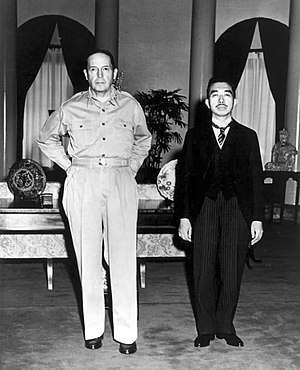
As the Emperor chose his uncle Prince Higashikuni as prime minister to assist the occupation, there were attempts by numerous leaders to have him put on trial for alleged war crimes. Many members of the imperial family, such as Princes Chichibu, Takamatsu, and Higashikuni, pressured the Emperor to abdicate so that one of the Princes could serve as regent until Crown Prince Akihito came of age.[74] On 27 February 1946, the Emperor's youngest brother, Prince Mikasa (Takahito), even stood up in the privy council and indirectly urged the Emperor to step down and accept responsibility for Japan's defeat. According to Minister of Welfare Ashida's diary, "Everyone seemed to ponder Mikasa's words. Never have I seen His Majesty's face so pale."[75]
U.S. General Douglas MacArthur insisted that Emperor Hirohito retain the throne. MacArthur saw the Emperor as a symbol of the continuity and cohesion of the Japanese people. Some historians criticize the decision to exonerate the Emperor and all members of the imperial family who were implicated in the war, such as Prince Chichibu, Prince Asaka, Prince Higashikuni, and Prince Hiroyasu Fushimi, from criminal prosecutions.[76]
Before the war crime trials actually convened, the SCAP, its International Prosecution Section (IPS) and Japanese officials worked behind the scenes not only to prevent the Imperial family from being indicted, but also to influence the testimony of the defendants to ensure that no one implicated the Emperor. High officials in court circles and the Japanese government collaborated with Allied GHQ in compiling lists of prospective war criminals, while the individuals arrested as Class A suspects and incarcerated solemnly vowed to protect their sovereign against any possible taint of war responsibility.[77] Thus, "months before the Tokyo tribunal commenced, MacArthur's highest subordinates were working to attribute ultimate responsibility for Pearl Harbor to Hideki Tōjō"[78] by allowing "the major criminal suspects to coordinate their stories so that the Emperor would be spared from indictment."[79] According to John W. Dower, "This successful campaign to absolve the Emperor of war responsibility knew no bounds. Hirohito was not merely presented as being innocent of any formal acts that might make him culpable to indictment as a war criminal, he was turned into an almost saintly figure who did not even bear moral responsibility for the war."[80] According to Bix, "MacArthur's truly extraordinary measures to save Hirohito from trial as a war criminal had a lasting and profoundly distorting impact on Japanese understanding of the lost war."[81]
Imperial status
Hirohito was not put on trial, but he was forced[82] to explicitly reject the quasi-official claim that the Emperor of Japan was an arahitogami, i.e., an incarnate divinity. This was motivated by the fact that, according to the Japanese constitution of 1889, the Emperor had a divine power over his country which was derived from the Shinto belief that the Japanese Imperial Family were the descendants of the sun goddess Amaterasu. Hirohito was however persistent in the idea that the Emperor of Japan should be considered a descendant of the gods. In December 1945, he told his vice-grand-chamberlain Michio Kinoshita: "It is permissible to say that the idea that the Japanese are descendants of the gods is a false conception; but it is absolutely impermissible to call chimerical the idea that the Emperor is a descendant of the gods."[83] In any case, the "renunciation of divinity" was noted more by foreigners than by Japanese, and seems to have been intended for the consumption of the former.[lower-alpha 4] The theory of a constitutional monarchy had already had some proponents in Japan. In 1935, when Tatsukichi Minobe advocated the theory that sovereignty resides in the state, of which the Emperor is just an organ (the tennō kikan setsu), it caused a furor. He was forced to resign from the House of Peers and his post at the Tokyo Imperial University, his books were banned, and an attempt was made on his life.[84] Not until 1946 was the tremendous step made to alter the Emperor's title from "imperial sovereign" to "constitutional monarch."
Although the Emperor had supposedly repudiated claims to divinity, his public position was deliberately left vague, partly because General MacArthur thought him probable to be a useful partner to get the Japanese to accept the occupation and partly due to behind-the-scenes maneuvering by Shigeru Yoshida to thwart attempts to cast him as a European-style monarch.
Nevertheless, Hirohito's status as a limited constitutional monarch was formalized with the enactment of the 1947 Constitution–officially, an amendment to the Meiji Constitution. It defined the Emperor as "the symbol of the state and the unity of the people," and stripped him of even nominal power in government matters. His role was limited to matters of state as delineated in the Constitution, and in most cases his actions in that realm were carried out in accordance with the binding instructions of the Cabinet.
Following the Iranian Revolution and the end of the short-lived Central African Empire, both in 1979, Hirohito found himself the last monarch in the world to bear any variation of the highest royal title "emperor."
Public figure
For the rest of his life, Hirohito was an active figure in Japanese life and performed many of the duties commonly associated with a constitutional head of state. He and his family maintained a strong public presence, often holding public walkabouts and making public appearances on special events and ceremonies. Such as in 1947 the Emperor made a public visit to Hiroshima and held a speech in front of a massive crowd encouraging the citizens of Hiroshima. He also played an important role in rebuilding Japan's diplomatic image, traveling abroad to meet with many foreign leaders, including Queen Elizabeth II (1971) and President Gerald Ford (1975). He was not only the first reigning emperor to travel beyond Japan, but also the first to meet a President of the United States.[85] His status and image became strongly positive in the United States.[86]
| Year | Go abroad | Return home | Visited | Accompany | Remarks |
|---|---|---|---|---|---|
| 1971 (Showa 46) | 27 September | 14 October | Empress Kojun | International friendship | |
| 1975 (Showa 50) | 30 September | 14 October | Empress Kojun | International friendship |
Visit to Europe
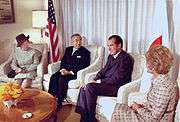
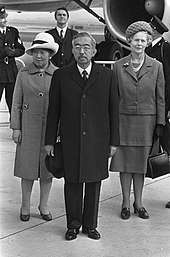
In 1971 (Showa 46), the Emperor visited seven European countries, including the United Kingdom, the Netherlands, and Switzerland again, for 17 days from 27 September to 14 October. In this case, a special aircraft Douglas DC-8 of Japan Airlines was used unlike the previous visit by ship. Although not counted as a visit, at that time, the Emperor stopped by Anchorage, Alaska as a stopover, and met with United States President Richard Nixon from Washington, DC, at the Alaska District Army Command House at Elmendorf Air Force Base.
The talks between Emperor Showa and President Nixon were not planned at the outset, because initially the stop in the United States was only for refueling to visit Europe. However, the meeting was decided in a hurry at the request of the United States. Although the Japanese side accepted the request, Minister for Foreign Affairs Takeo Fukuda made a public telephone call to the Japanese ambassador to the United States Nobuhiko Ushiba, who promoted talks, saying, "that will cause me a great deal of trouble. We want to correct the perceptions of the other party." At that time, Foreign Minister Fukuda was worried that President Nixon's talks with the Emperor would be used to repair the deteriorating Japan-U.S. Relations, and he was concerned that the premise of the symbolic emperor system could fluctuate.[88][89]
There was an early visit, with deep royal exchanges in Denmark and Belgium, and in France they were warmly welcomed. In France, Hirohito reunited with Edward VIII, formerly known as Duke of Windsor, who was forced to leave Britain after his abdication and was virtually in exile, and they chatted for a while. However, protests were held in Britain and the Netherlands by veterans who had served in the South-East Asian theatre. In the Netherlands, raw eggs and vacuum flasks were thrown by right-wing forces. The protest was so severe that Empress Kojun, who accompanied the Emperor, was exhausted. In the United Kingdom, protestors stood in silence and turned their backs when the Emperor's carriage passed them while others wore red gloves to symbolize the dead.[90] The satirical magazine Private Eye used a racist double entendre to refer to the emperor's visit ("nasty Nip in the air").[91]
Regarding these protests and opposition, Emperor Showa was not surprised to have received a report in advance at a press conference on 12 November after returning to Japan and said that "I do not think that welcome can be ignored" from each country.[92] Also, at a press conference following their golden wedding anniversary three years later, along with the Empress, he mentioned this visit to Europe as his most enjoyable memory in 50 years.[92]
Visit to the United States
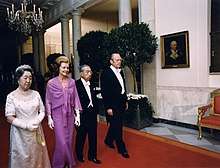
In 1975, the Emperor was invited to visit the United States for 14 days from 30 September to 14 October, at the invitation of then-US President Gerald R. Ford. The visit to the United States after the emperor's throne was the first event in history.[lower-alpha 5] The United States Army, Navy and Air Force, as well as the Marine Corps and the Coast Guard honored the state visit. Before and after the Emperor's visit to the United States, a series of terrorist attacks in Japan were caused by anti-American left-wing organizations such as the East Asia Anti-Japan Armed Front.
After arriving in Williamsburg, Emperor Showa stayed in the United States for two weeks, overturning expectations before visiting the United States, and was greatly welcomed in places he visited, including Washington, D.C. and Los Angeles. The Official meeting with President Ford was on 2 October, the offering of flowers to the graves of unknown soldiers at Arlington National Cemetery occurred on 3 October, visiting Rockefeller House in New York was on 4 October with media in the U.S. Then, the front page of newspapers had a photograph of Emperor Showa. When visiting New York, the Pearl Harbor Survivors Association, which consists of survivors of the Attack on Pearl Harbor, adopted the Emperor's Welcome Resolution . During his visit to the United States, he seemed to be a scholar , with many occasions at Botanical gardens.
In a speech at the White House state dinner, Hirohito read, "Thanks to the United States for helping to rebuild Japan after the war." During his stay in Los Angeles, he visited Disneyland, and a smiling photo next to Mickey Mouse adorned the newspapers , and there was talk about the purchase of a Mickey Mouse watch. Two types of commemorative stamps and stamp sheets were issued on the day of their return to Japan which demonstrated that this visit to the United States was a major undertaking. This was the last visit of Emperor Showa to the United States. The official press conference held by the Emperor and Empress before and after their visit to the United States also marked a breakthrough .
Marine biology

The Emperor was deeply interested in and well-informed about marine biology, and the Imperial Palace contained a laboratory from which the Emperor published several papers in the field under his personal name "Hirohito."[93] His contributions included the description of several dozen species of Hydrozoa new to science.[94]
Yasukuni Shrine
Emperor Hirohito maintained an official boycott of the Yasukuni Shrine after it was revealed to him that Class-A war criminals had secretly been enshrined after its post-war rededication. This boycott lasted from 1978 until his death. This boycott has been maintained by his son Akihito.
On 20 July 2006, Nihon Keizai Shimbun published a front-page article about the discovery of a memorandum detailing the reason that the Emperor stopped visiting Yasukuni. The memorandum, kept by former chief of Imperial Household Agency Tomohiko Tomita, confirms for the first time that the enshrinement of 14 Class-A war criminals in Yasukuni was the reason for the boycott. Tomita recorded in detail the contents of his conversations with the Emperor in his diaries and notebooks . According to the memorandum, in 1988, the Emperor expressed his strong displeasure at the decision made by Yasukuni Shrine to include Class-A war criminals in the list of war dead honored there by saying, "At some point, Class-A criminals became enshrined, including Matsuoka and Shiratori. I heard Tsukuba acted cautiously." Tsukuba is believed to refer to Fujimaro Tsukuba, the former chief Yasukuni priest at the time, who decided not to enshrine the war criminals despite having received in 1966 the list of war dead compiled by the government. "What's on the mind of Matsudaira's son, who is the current head priest?" "Matsudaira had a strong wish for peace, but the child didn't know the parent's heart. That's why I have not visited the shrine since. This is my heart." Matsudaira is believed to refer to Yoshitami Matsudaira, who was the grand steward of the Imperial Household immediately after the end of World War II. His son, Nagayoshi, succeeded Fujimaro Tsukuba as the chief priest of Yasukuni and decided to enshrine the war criminals in 1978.[95] Nagayoshi Matsudaira died in 2006, which some commentators have speculated is the reason for release of the memo.
Death and state funeral
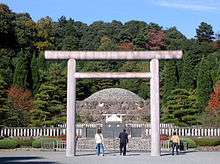
On 22 September 1987, the Emperor underwent surgery on his pancreas after having digestive problems for several months. The doctors discovered that he had duodenal cancer. The Emperor appeared to be making a full recovery for several months after the surgery. About a year later, however, on 19 September 1988, he collapsed in his palace, and his health worsened over the next several months as he suffered from continuous internal bleeding. On 7 January 1989, at 7:55 AM, the grand steward of Japan's Imperial Household Agency, Shoichi Fujimori, officially announced the death of Emperor Hirohito at 6:33 AM and revealed details about his cancer for the first time. Hirohito was survived by his wife, his five surviving children, ten grandchildren, and one great-grandchild.[12]
At the time of his death he was both the longest-lived and longest-reigning historical Japanese emperor, as well as the longest-reigning monarch in the world at that time. The latter distinction would pass to king Bhumibol Adulyadej of Thailand.[96]
The Emperor was succeeded by his son, the Emperor Akihito, whose enthronement ceremony was held on 12 November 1990.
The Emperor's death ended the Shōwa era. On the same day a new era began: the Heisei era, effective at midnight the following day. From 7 January until 31 January, the Emperor's formal appellation was "Departed Emperor." His definitive posthumous name, Shōwa Tennō, was determined on 13 January and formally released on 31 January by Toshiki Kaifu, the prime minister.
On 24 February, Emperor Hirohito's state funeral was held, and unlike that of his predecessor, it was formal but not conducted in a strictly Shinto manner. A large number of world leaders attended the funeral. Emperor Hirohito is buried in the Musashi Imperial Graveyard in Hachiōji, alongside Emperor Taishō, his father.
Honours
Military appointments
- Second Lieutenant, IJA and Second Sub-Lieutenant, IJN (9 September 1912)
- Lieutenant, IJA and Sub-Lieutenant, IJN (31 October 1914)
- Captain, IJA and Lieutenant, IJN (31 October 1916)
- Major, IJA and Lieutenant-Commander, IJN (31 October 1920)
- Lieutenant-Colonel, IJA and Commander, IJN (31 October 1923)
- Colonel, IJA and Captain, IJN (31 October 1924)
- Grand Marshal and Supreme Commander-in-Chief of the Empire of Japan (25 December 1926; upon ascending the throne)[97]
Foreign military appointments


National honours
- Collar and Grand Cordon of the Supreme Order of the Chrysanthemum
- Grand Cordon of the Order of the Rising Sun with Paulownia Blossoms
- Grand Cordon of the Order of the Golden Kite (abolished in 1947)
- Grand Cordon of the Order of the Sacred Treasure
Foreign honours
.svg.png)








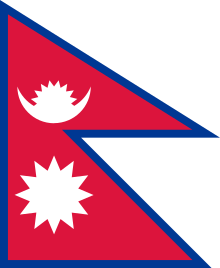



.svg.png)
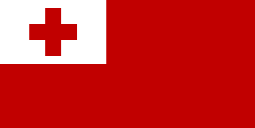




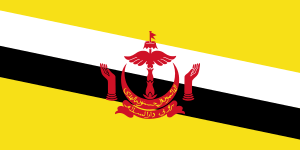
.svg.png)
.svg.png)
.svg.png)
.svg.png)

Issue
Emperor Showa and Empress Kojun had seven children, two sons and five daughters.
| Name | Birth | Death | Marriage | Issue | |
|---|---|---|---|---|---|
| Shigeko, Princess Teru | 9 December 1925 | 23 July 1961 | 10 October 1943 | Prince Morihiro Higashikuni | Prince Nobuhiko Higashikuni Princess Fumiko Higashikuni Naohiko Higashikuni Hidehiko Higashikuni Yūko Higashikuni |
| Sachiko, Princess Hisa | 10 September 1927 | 8 March 1928 | |||
| Kazuko, Princess Taka | 30 September 1929 | 26 May 1989 | 20 May 1950 | Toshimichi Takatsukasa | Naotake Takatsukasa (adopted) |
| Atsuko, Princess Yori | 7 March 1931 | 10 October 1952 | Takamasa Ikeda | ||
| Akihito, Emperor Emeritus of Japan | 23 December 1933 | 10 April 1959 | Michiko Shōda | Naruhito, Emperor of Japan Fumihito, Prince Akishino Sayako, Princess Nori | |
| Masahito, Prince Hitachi | 28 November 1935 | 30 September 1964 | Hanako Tsugaru | ||
| Takako, Princess Suga | 2 March 1939 | 10 March 1960 | Hisanaga Shimazu | Yoshihisa Shimazu | |
Ancestry
| 8. Osahito, Emperor Kōmei (1831–1867) | |||||||||||||||
| 4. Mutsuhito, Emperor Meiji (1852–1912) | |||||||||||||||
| 9. Lady Nakayama Yoshiko (1836–1907) | |||||||||||||||
| 2. Yoshihito, Emperor Taishō (1879–1926) | |||||||||||||||
| 10. Yanagihara Mitsunaru (1818–1885) | |||||||||||||||
| 5. Lady Yanagihara Naruko (1859–1943) | |||||||||||||||
| 11. Utano Hasegawa (1832–1891) | |||||||||||||||
| 1. Hirohito, Emperor Shōwa | |||||||||||||||
| 12. Kujō Hisatada (1798–1871) | |||||||||||||||
| 6. Prince Kujō Michitaka (1839–1906) | |||||||||||||||
| 13. Lady Karahashi Meiko (1796–1881) | |||||||||||||||
| 3. Sadako, Empress Teimei (1884–1951) | |||||||||||||||
| 14. Noma Yorioki | |||||||||||||||
| 7. Noma Ikuko | |||||||||||||||
| 15. Yamokushi Kairi | |||||||||||||||
Scientific publications
- (1967) A review of the hydroids of the family Clathrozonidae with description of a new genus and species from Japan.[120]
- (1969) Some hydroids from the Amakusa Islands.[121]
- (1971) Additional notes on Clathrozoon wilsoni Spencer.[122]
- (1974) Some hydrozoans of the Bonin Islands[123]
- (1977) Five hydroid species from the Gulf of Aqaba, Red Sea.[124]
- (1983) Hydroids from Izu Oshima and Nijima.[125]
- (1984) A new hydroid Hydractinia bayeri n. sp. (family Hydractiniidae) from the Bay of Panama.[126]
- (1988) The hydroids of Sagami Bay collected by His Majesty the Emperor of Japan.[127]
- (1995) The hydroids of Sagami Bay II. (posthumous)[128]
See also
- Empire of Japan
- Japanese nationalism
- List of Emperors of Japan
- Jewel Voice Broadcast – "Gyokuon-hōsō"
- Otoya Yamaguchi
- The Sun – a biographical film about the Emperor
Notes
- /ˌhɪəroʊˈhiːtoʊ, ˌhɪrəˈ-/,[1][2] Japanese: [çiɾoꜜçi̥to]
- The first foreign trip made by the Crown Prince was made in 1907 by the Crown Prince Yoshihito to the then Korean Empire. During that time, while it was considered a foreign country, it had become a colonial protectorate of Japan and would be eventually be annexed.
- Former member of section 20 of War operations of the Army high command, Hara has made a detailed study of the way military decisions were made, including the Emperor's involvement published in five volumes in 1973–74 under the title Daihon'ei senshi; Daitōa Sensō kaisen gaishi; Kaisen ni itaru seisentyaku shidō (Imperial Headquarters war history; General history of beginning hostilities in the Greater East Asia War; Leadership and political strategy with respect to the beginning of hostilities).
- Many foreigners, including those from the occupying power, were from Western countries steeped in monotheistic Abrahamic traditions.
- The reason a visit had not occurred prior to this was, in part, due to the fact that the Act for Extraordinary Vicarious Execution of State Affairs had not yet been put into law. Despite this, visits to the United States had been planned in 1973 and 1974, but never occurred due to lack of coordination.
References
Citations
- "Hirohito". Collins English Dictionary. HarperCollins.
- "Hirohito" (US) and "Hirohito". Oxford Dictionaries UK Dictionary. Oxford University Press. Retrieved 30 April 2019.
- Northedge, Frederick S. (1986). The League of Nations: Its Life and Times, 1920–1946. New York: Holmes & Meier. pp. 42–48. ISBN 978-0841910652.
- Yoshimi, Yoshiaki; Matsuno, Seiya (1997). Dokugasusen Kankei Shiryō II (毒ガス戦関係資料. II), Kaisetsu. Jugonen Sensō Gokuhi Shiryoshu (十五年戦争極秘資料集). Tōkyō: Fuji Shuppan. pp. 27–29.
- Maddison, Angus, Contours of the World Economy, 1–2030 AD. 2007, p. 379, table A.4.
- BBC - History - Historic Figures: Emperor Hirohito (1901-1989)
- Ponsonby-Fane, Richard. (1959). The Imperial House of Japan, p. 337.
- Bix, Herbert P. (2001). Hirohito and the making of modern Japan (Book) (1st Perennial ed.). New York: Perennial. pp. 22–23. ISBN 978-0060931308.
- Ponsonby-Fane, p. 338; 'see File:Crowd awaiting Crown Prince Tokyo Dec1916.jpg, New York Times. 3 December 1916.
- 小田部雄次 『天皇・皇室を知る事典』211頁(東京堂出版・2007年)
- 早野透 (September 2001). "(97)昭和天皇". In 朝日新聞社 編 (ed.). 100人の20世紀. 朝日文庫. 下. 朝日新聞社. p. 445. ISBN 4022613513.
- "Hirohito's survivors". Latimes.com. 7 January 1989. Retrieved 3 December 2016.
- Varley, H. Paul, ed. (1980). Jinnō Shōtōki ("A Chronicle of Gods and Sovereigns: Jinnō Shōtōki of Kitabatake Chikafusa" translated by H. Paul Varley), p. 44. [A distinct act of senso is unrecognized prior to Emperor Tenji; and all sovereigns except Jitō, Yōzei, Go-Toba, and Fushimi have senso and sokui in the same year until the reign of Go-Murakami;] Ponsonby-Fane, p. 350.
- Ponsonby-Fane, p. 349.
- Ponsonby-Fane, pp. 136–137.
- Mikiso Hane, Emperor Hirohito and His Chief Aide-de-camp, The Honjō Diary, 1983; Honjō Nikki, Hara Shobō, 1975.
- Wakabayashi, Bob Tadashi (1991). "Emperor Hirohito on Localized Aggression in China" (PDF). Sino-Japanese Studies. 4 (1): 4–27. Archived from the original (PDF) on 21 July 2011. Retrieved 3 February 2008.
- Fujiwara, Nitchū Sensō ni Okeru Horyo Gyakusatsu, Kikan Sensō Sekinin Kenkyū 9, 1995, pp. 20-21.
- Dokugasusen Kankei Shiryō II, Kaisetsu, 1997, pp. 25–29.
- Dokugasusen Kankei Shiryō II, Kaisetsu, 1997, p. 28.
- Hidenari, pp. 106–108, Wetzler, pp. 25, 231.
- Bix, Herbert P. (2001). Hirohito and the Making of Modern Japan. Harper Collins. pp. 411, 745. ISBN 9780060931308.
- MacArthur. "Chapter III: Politico-Military Evolution Toward War". www.history.army.mil. Retrieved 17 September 2016.
- "Historical Events Today: 1867 – Prince Mutsuhito, 14, becomes Emperor Meiji of Japan (1867–1912)". This-is-japan.com. July 22, 2002. Archived from the original on December 29, 2016. Retrieved December 3, 2016.
- Wetzler, pp. 52–54.
- Fujiwara, Shōwa tennō no jūgo-nen sensō, 1991, p. 126, citing Kenji Tomita's diary.
- Hidenari, p. 118.
- Bix, p. 421; Wetzler, pp. 47–50.
- Day of Deceit, Robert B. Stinnett, New York, 2000, p. 143.
- Wetzler, pp. 29, 35.
- Bix, pp. 424, 430-31
- Bartsch, William H. (2003). December 8, 1941: MacArthur's Pearl Harbor. p.187.
- Yamada, pp. 180, 181, 185; Fujiwara, pp. 135–138.
- Akamatsu's diary, in Wetzler, p. 50.
- Herbert Bix, "Emperor Hirohito's war," History Today, (Dec 1991), 41#12
- Herbert P. Bix "Japan's Delayed Surrender: a Reinterpretation." Diplomatic History 1995 19(2): 197-225. online.
- David C. Earhart, Certain Victory: Images of World War II in the Japanese Media (2015).
- Robert A. Pape (2014). Bombing to Win: Air Power and Coercion in War. pp. 117–118. ISBN 9780801471513.
- Bix, p. 756.
- Fujita Hisanori, Jijûchô no kaisô, Chûô Kôronsha, 1987, pp. 66–67, Bix, p. 489.
- Kido Kōichi Nikki, p. 1223.
- Hidenari, p. 129.
- Storry, Richard (1991). A History of Modern Japan. Penguin.
- "Hirohito's "Jewel Voice Broadcast"". The Air Force Association. August 2012. Archived from the original on 10 September 2013. Retrieved 14 August 2013.
- Bix, p. 676; Dower, p. 606.
- Divine, Dr. Robert A. (2005). Warriors and Scholars: A Modern War reader., edited by Peter B. Lane and Ronald E. Marcello, pp. 94-96
- Dian, Matteo (2017). Contested Memories in Chinese and Japanese Foreign Policy., p.82
- He, Yinan (2009). The Search for Reconciliation:Sino-Japanese and German-Polish Relations since World War II., pp. 125 and 126
- "Atomic Heritage Foundation: Emperor Hirohito".
- Laquerre, Paul-Yanic (2013). Showa: Chronicles of a Fallen God., Preface
- "Hirohito "uncomfortable" with war but powerless to stop" (website). Kyodo News. 20 July 2017. Archived from the original on 14 December 2018. Retrieved 23 February 2020.
- Dower.
- Bix.
- "The Constitution of the Empire of Japan(1889)".
- Fujiwara, Akira (1991). Shōwa Tennō no Jū-go Nen Sensō (The Shōwa Emperor fifteen years war).
- Wetzler.
- Chira, Susan (22 January 1989). "Post-Hirohito, Japan Debates His War Role". New York Times. Retrieved 10 April 2009.
- Shōwa tennō no Jū-go nen sensō, Aoki Shoten, 1991, p. 122.
- Sanger, David (19 January 1990). "Mayor Who Faulted Hirohito Is Shot". New York Times. Retrieved 10 April 2009.
- Awaya, Kentarō. "The Tokyo Tribunal, War Responsibility and the Japanese People". Japan Focus. Timothy Amos trans. The Asia-Pacific Journal. Retrieved 10 April 2009.
- Fleury, Jean Sénat (2019). Hirohito: Guilty or Innocent. Prologue.
- Yamaguchi, Mari (27 July 2018). "Newly released 1941 memo says Emperor Hirohito 'at ease' with attack on Pearl Harbor". Honolulu Star-Advertiser. Retrieved 26 February 2020.
- "Diary tells of Emperor Hirohito's anguish in final years over blame for war" (website). The Japan Times Online. The Japan Times. 23 August 2018. Archived from the original on 29 May 2019. Retrieved 23 February 2020.
- Rich, Motoko (24 August 2018). "Aide's Diary Suggests Hirohito Agonized Over His War Responsibility". New York Times. Retrieved 26 February 2020.
- Fleury, chapter 4.
- "SDHF Newsletter No. 18: "Dissentient Judgment of Justice Pal" | Society for the Dissemination of Historical Fact". www.sdh-fact.com. Retrieved 17 June 2018.
- "The Tokyo Judgment and the Rape of Nanking", by Timothy Brook, The Journal of Asian Studies, August 2001.
- 陛下、お尋ね申し上げます 1988 p.209
- 陛下、お尋ね申し上げます 1988 p.212
- 陛下、お尋ね申し上げます 1988 p.216
- 陛下、お尋ね申し上げます 1988 p.226-227
- 昭和天皇語録 2004 p.332
- 陛下、お尋ね申し上げます 1988 p.313
- Bix, pp. 571–573.
- Ashida Hitoshi Nikki, Dai Ikkan, Iwanami Shoten, 1986, p. 82.
- Dower, Bix.
- Dower, p. 325.
- Dower, p. 585.
- Dower, p. 583.
- Dower, p. 326.
- Bix, p. 585.
- Dower 1999, p. 308–318.
- Wetzler, p. 3.
- Large, Stephen S.; Emperor Hirohito and Showa Japan: A Political Biography, p. 60; Routledge, 1992.
- Hirohito | Biography, Accomplishments, & Facts | Britannica
- Brands, Hal (2006). "The Emperor's New Clothes: American Viewsof Hirohito after World War II". Historian. 68 (1): 1–28. doi:10.1111/j.1540-6563.2006.00133.x.
- 『皇族 天皇家の近現代史』小田部雄次 中公新書 2011
- "米側の昭和天皇政治利用に外相が「迷惑千万」 外交文書公開". MSN産経ニュース. 7 March 2013. Archived from the original on 10 March 2013. Retrieved 7 March 2013.
- 東洋英和女学院大学大学院:国際協力研究科、増田弘>外交文書公開に関する備忘録
- "Nine controversial state visits to the UK". Sky News. Retrieved 6 June 2020.
- Popham, Peter (15 May 1996). "A love affair at work turns sour". The Independent. Retrieved 15 September 2018.
- 陛下、お尋ね申し上げます 1988 p.193
- "The brief career of the Emperor Showa (Imperial Household Agency, Japanese)". Kunaicho.go.jp. Retrieved 3 October 2010.
- "Hydrozoa Taxon List". World Hydrozoa Database. Retrieved 6 January 2016.
- "Hirohito visits to Yasukuni stopped over war criminals | The Japan Times Online". The Japan Times Online. Search.japantimes.co.jp. 21 July 2006. Retrieved 3 October 2010.
- "Chapter V: The Imperial Court – The Imperial House and The Reigning Sovereign," pg 46. The Japan-Manchoukuo Year Book 1938, The Japan-Manchoukuo Year Book Co., Tokyo.
- "No. 32324". The London Gazette (Supplement). 13 May 1921. p. 3917.
- "No. 32317". The London Gazette (Supplement). 9 May 1921. p. 3737.
- "No. 33619". The London Gazette. 27 June 1930. p. 4028.
- "Suomen Valkoisen Ruusun Suurristi Ketjuineen". ritarikunnat.fi (in Finnish). Retrieved 7 May 2020.
- Sveriges statskalender (in Swedish), 2, 1940, p. 7, retrieved 6 January 2018 – via runeberg.org
- Jørgen Pedersen (2009). Riddere af Elefantordenen, 1559–2009 (in Danish). Syddansk Universitetsforlag. p. 466. ISBN 978-87-7674-434-2.
- Kawalerowie i statuty Orderu Orła Białego 1705-2008 (2008), p. 298
- แจ้งความสำนักนายกรัฐมนตรี เรื่อง ถวายเครื่องราชอิสริยาภรณ์แด่สมเด็จพระจักรพรรดิแห่งประเทศญี่ปุ่น (PDF) (in Thai). www.ratchakitcha.soc.go.th. Retrieved 31 December 2014.
- Royal Thai Government Gazette (31 January 1925). "ส่งเครื่องขัตติยราชอิสริยาภรณ์ไปพระราชทาน" (PDF) (in Thai). Retrieved 8 May 2019.
- Omsa.org
- GOVPH. "The Order of Sikatuna". Official Gazette of the Republic of the Philippines. Retrieved 3 December 2016.
- "Viagem do Presidente Geisel ao Japão". September 1976. Retrieved 15 May 2018.
- "Le onorificenze della Repubblica Italiana". www.quirinale.it.
- wearing the order ribbon bar on his left chest
- "No. 32318". The London Gazette (Supplement). 9 May 1921. p. 3747.
- "Britain wanted limited restoration of royal family's honors", Japan Policy & Politics. 7 January 2002.
- Corner, E. J. H. (1990). "His Majesty Emperor Hirohito of Japan, K. G. 29 April 1901-7 January 1989". Biographical Memoirs of Fellows of the Royal Society. 36: 242–272. doi:10.1098/rsbm.1990.0032.
- "Boletín Oficial del Estado" (PDF). Retrieved 3 December 2016.
- Naval History: Hirohito Showa.
- "Real y distinguida orden de Carlos III", Guía Oficial de España (in Spanish), 1930, p. 221, retrieved 7 June 2020
- "Kolana Řádu Bílého lva aneb hlavy států v řetězech" (in Czech), Czech Medals and Orders Society. Retrieved 2018-08-09.
- "Genealogy". Reichsarchiv (in Japanese). Retrieved 24 October 2017.
- "A review of the hydroids of the family Clathrozonidae with description of a new genus and species from Japan". Hathi Trust Digital Library. 1967. Retrieved 25 December 2016.
- Some hydroids from the Amakusa Islands. Hathi Trust Digital Library. 1969. Retrieved 25 December 2016.
- Additional notes on Clathrozoon wilsoni Spencer / by Hirohito, Emperor of Japan. Hathi Trust Digital Library. 1971. Retrieved 25 December 2016.
- Some hydrozoans of the Bonin Islands. Stanford University Libraries. 25 February 1974.
- Five hydroid species from the Gulf of Aqaba, Red Sea / by Hirohito. Hathi Trust Digital Library. 1977. Retrieved 25 December 2016.
- Hydroids from Izu Ôshima and Niijima. World Cat. OCLC 647103657.
- A new hydroid Hydractinia bayeri n.sp. (family Hydractiniidae) from the Bay of Panama. Stanford University Libraries. 25 February 1984. Retrieved 25 December 2016.
- The Hydroids of Sagami Bay / by Hirohito, Emperor of Japan. National Library of Australia. 1988. Retrieved 25 December 2016.
- The hydroids of Sagami Bay. II, Thecata. World Cat. OCLC 154263373.
Sources
- Behr, Edward (1989). Hirohito: Behind the Myth. New York: Villard. ISBN 9780394580722. A controversial book that posited Hirohito as a more active protagonist of World War II than publicly portrayed; it contributed to the re-appraisal of his role.
- Herbert P. Bix (2000). Hirohito And The Making Of Modern Japan. Harper. ISBN 978-0-06-019314-0. Winner of the 2001 Pulitzer Prize for General Non-Fiction and the 2000 National Book Critics Circle Award for Biography.
- Dower, John W. (1999). Embracing Defeat: Japan in the Wake of World War II. W. W. Norton & Company. ISBN 978-0-393-32027-5.CS1 maint: ref=harv (link) awarded Pulitzer Prize and National Book Award.
- Drea, Edward J. (1998). "Chasing a Decisive Victory: Emperor Hirohito and Japan's War with the West (1941–1945)". In the Service of the Emperor: Essays on the Imperial Japanese Army. Nebraska: University of Nebraska Press. ISBN 978-0-8032-1708-9. online at Questia
- Fujiwara, Akira, Shōwa Tennō no Jū-go Nen Sensō (Shōwa Emperor's Fifteen-year War), Aoki Shoten, 1991. ISBN 4-250-91043-1 (Based on the primary sources)
- Hidenari, Terasaki Shōwa tennō dokuhakuroku, Bungei Shūnjusha, 1991
- Edwin Palmer Hoyt (1992). Hirohito: The Emperor and the Man. Praeger Publishers. ISBN 978-0-275-94069-0.
- Toshiaki Kawahara (1990). Hirohito and His Times: A Japanese Perspective. Kodansha America. ISBN 978-0-87011-979-8.
- Laquerre, Paul-Yanic Showa: Chronicles of a Fallen God, ISBN 978-1729431597 ASIN: B00H6W4TYI
- Mosley, Leonard Hirohito, Emperor of Japan, Prentice-Hall, Englewood Cliffs, 1966. ISBN 1-111-75539-6 ISBN 1-199-99760-9, The first full-length biography, it gives his basic story.
- Richard Arthur Brabazon Ponsonby-Fane (1959). The Imperial House of Japan. Ponsonby Memorial Society.
- Wetzler, Peter (1998). Hirohito and War: Imperial Tradition and Military Decision Making in Prewar Japan. University of Hawaii Press. ISBN 978-0-8248-1925-5.
External links


- Emperor Shōwa and Empress Kōjun at the Imperial Household Agency website
- Reflections on Emperor Hirohito's death
- Hirohito on IMDb
- Newspaper clippings about Hirohito in the 20th Century Press Archives of the ZBW
Hirohito Born: 29 April 1901 Died: 7 January 1989 | ||
| Regnal titles | ||
|---|---|---|
| Preceded by Emperor Taishō (Yoshihito) |
Emperor of Japan 25 December 1926 – 7 January 1989 |
Succeeded by Emperor Akihito |


